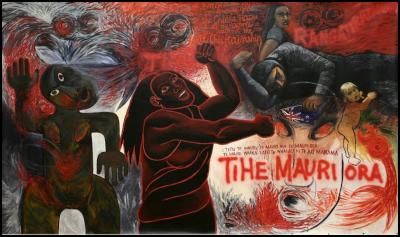Paheka Colonisation & Maori Empowerment, Paintings
MEDIA RELEASE
15 February – 11 April 2010
TE
HURINGA/ TURNING POINTS
Paheka Colonisation and Maori
Empowerment
An Exhibition of Paintings from the Collections of the Fletcher Trust and Sarjeant Gallery Te Whare O Rehua Whanganui

Click for big version
Robyn Kahukiwa B. 1940
Tihe Mauri Ora
Oil on Unstretched Canvas 1990
the Fletcher Trust Collection
The long curvaceous peninsula of Northland/Te Tai Tokerau can claim a very unique place in the social, political and cultural memory of our country. As birthplace of a nation and a significant first point of social interaction between Maori and Pakeha, Northland also became a seedbed for artistic expression after the colonial era. Te Huringa – the Turning Point Pakeha Colonisation and Maori Empowerment is a major exhibition of New Zealand art and
historical responses to a new social order, and consequent reclaiming of old values, as viewed by contemporary artists in the mid to late 20th century. Described eloquently as ‘like a travelator back though a pictorial history of Aotearoa’ Whangarei Art Museum is proud to be able to bring this highly important exhibition to Northland on the ‘final leg’ of its national tour.
Many thousands have visited the exhibition all over New Zealand - 42,000 in Wellington alone. The exhibition has been supported by the Fletcher Trust (and Angus Fletcher in particular whose father Sir James Fletcher began the art collection), Te Puni Kokiri and Maori Television, indicating its cultural significance. Prestigious art museums such as the City Gallery Wellington, Christchurch Art Gallery, and the Dunedin Public Art Gallery have hosted the exhibition which contains works by many of the most important artists of their era.
Spanning two centuries from the post-Contact period these include Augustus Earle, Nicolas Chevalier, John Louis Steele and Charles Goldie, Sir Horatio Robley, Russell Clark, Colin McCahon, Gordon Walters Ralph Hotere, Robyn Kahukiwa and Shane Cotton and many many more. This is a visually sumptuous and compelling exhibition filling the entire museum galleries with resonant images and deeply relevant text information from dual maori and pakeha perspectives on the themes of the exhibition.
This ground-breaking approach to curatorship with two adjacent perspectives to the same work show how interpretation can differ according to the cultural backgrounds of the viewer. The exhibition is designed to appeal to all ages and levels of art knowledge – or those who want to engage with the important themes in past and recent New Zealand history.
The two co-curators of the exhibition; author, art critic and curator of the Fletcher Trust collection Peter Shaw and Ngapuhi academic Dr Jo Diamond write;
The encounters between people of different cultural backgrounds always provide opportunities for ongoing critical engagement. In Aotearoa/New Zealand, such early encounters had repercussions that remain with us today. Artists brought, innocently or not, their own cultural baggage to their subject matter. One such example is Francis Dillon Bell’s New Zealand Bush, c.1845, which turns out to be far more than a mere botanical record. This, like so many other paintings included in Te Huringa/Turning Points, can be seen to have multiple and sometimes unexpected additional meanings.
A great many of the works have their origin in deep contention. This resulted from disputes over land that were the inevitable consequence of colonialism. In our time, these disputes gave rise to protests, including land rights hikoi,
and, more recently, have prompted hopeful participation in partnership deals between Maori and Pakeha. This exhibition provides a huringa, a turning point, in our ability to view art critically. It offers an ideal opportunity to give some emphasis to a Maori viewpoint without excluding non-Maori points of view. This is reflected in our two different curatorial approaches, one Maori, the other Pakeha.
If this is seen as controversial we make no apology. It mirrors the complex, convoluted history of race relations in this country. Curatorially, we offer it as a koha towards a more thoughtful engagement with various – in many cases iconic – works held in the Fletcher and Sarjeant Gallery collections.
Each work is arranged in a thematic framework, not in an effort to fit it into a rigid category but to suggest pathways for consideration and to provide sometimes unexpected links between paintings which might not otherwise be thought of as connected.
Dr Jo Diamond & Peter Shaw
Curators
Further information can be obtained by contacting: Whangarei Art Museum
ENDS


 Taite Music Prize: The 2025 Taite Music Prize Winner Is MOKOTRON - WAEREA
Taite Music Prize: The 2025 Taite Music Prize Winner Is MOKOTRON - WAEREA Health Committee: Have Your Say On The Medicines Amendment Bill
Health Committee: Have Your Say On The Medicines Amendment Bill PHCC: Free Vape Kits Won’t Deliver Smokefree 2025 Goal
PHCC: Free Vape Kits Won’t Deliver Smokefree 2025 Goal New Zealand Association of Scrabble Players: Who Will Be New Zealand’s Masters Scrabble Champion For 2025?
New Zealand Association of Scrabble Players: Who Will Be New Zealand’s Masters Scrabble Champion For 2025? Paralympics New Zealand: Matthew Britz And Wojtek Czyz Receive Paralympian Pins
Paralympics New Zealand: Matthew Britz And Wojtek Czyz Receive Paralympian Pins Tennis NZ: New Zealand Billie Jean King Cup Team Qualify For World Group Play-Offs
Tennis NZ: New Zealand Billie Jean King Cup Team Qualify For World Group Play-Offs